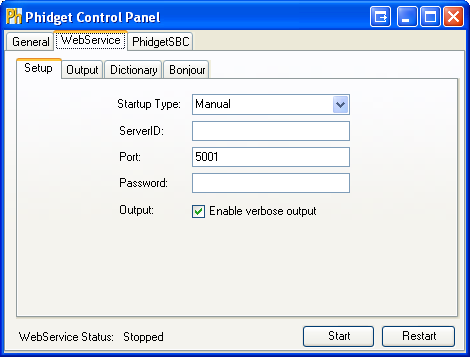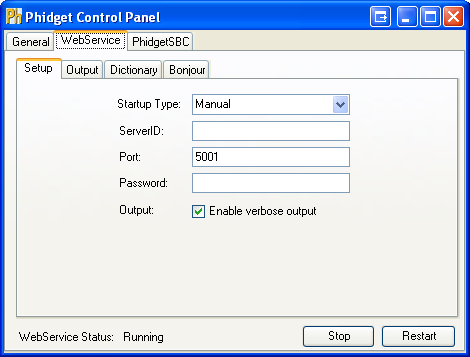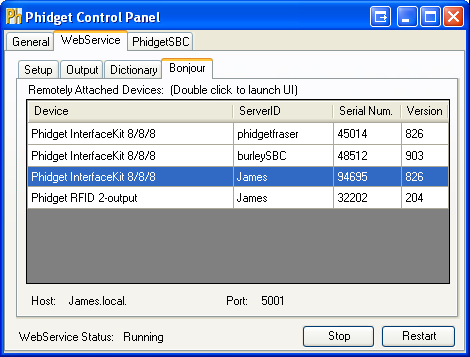|
Notice: This page contains information for the legacy Phidget21 Library. Phidget21 is out of support. Bugfixes may be considered on a case by case basis. Phidget21 does not support VINT Phidgets, or new USB Phidgets released after 2020. We maintain a selection of legacy devices for sale that are supported in Phidget21. We recommend that new projects be developed against the Phidget22 Library.
|
OS - Windows CE
![]() On Windows CE, Phidgets can be either plugged directly into a USB Port or run over a network using the Webservice.
On Windows CE, Phidgets can be either plugged directly into a USB Port or run over a network using the Webservice.
Phidgets are designed to run on Windows CE 5.0 or newer.
Getting Started (Libraries and Drivers)
If this is your first Phidget, we highly recommend working through the Getting Started guide for your specific Phidget device. If you already have the ![]() icon in your task bar and know how to use it, then you've already followed the guide and are ready to learn more about the control panel, the Phidget Webservice, and more - all specific to Windows.
icon in your task bar and know how to use it, then you've already followed the guide and are ready to learn more about the control panel, the Phidget Webservice, and more - all specific to Windows.
If you are already a pro, and just want the drivers:
For special cases where you want to install the Phidget libraries without the installer, please see the Advanced Uses section.
- Phidget21 WinCE Libraries (All architectures)
- Kernel Driver Source
- Software License
Installing
On the Windows CE machine, the Phidget installer requires that you install the correct package for your machine(ARMV4I, x86, or MIPSII).
To install the libraries, follow these steps:
1. Download one of the Phidget installer for your system, depending on whether your system is ARM4VI, x86, or MIPSII.
2. Open up the CAB installer, and proceed through the wizard. If you have installed the Phidgets library before on the same system, it may mention that the Phidget libraries are already installed. This is safe to ignore.
Please note that by default, the installer places the Phidget libraries in \Program Files\Phidgets.
3. Once the installation is complete, you are ready to program with Phidgets.
For a description of what was installed onto your system, please see the Description of Library Files section.
Proceed onto to the next section where the Phidget Control Panel will be discussed.
Checking
To confirm the libraries were installed and work correctly, you can check if the software side works.
If you have the Phidgets library installed on your system, you can verify that the software side is working by running the \Program Files\Phidgets\HelloWorld.exe application seeing if the Phidget device is listed in the output.
If the Phidget is plugged into a USB port and you are not able to see that the Phidget is in the list, there may be a hardware issue.
Troubleshooting
If the examples do not work but USB does work (i.e. your computer can consistently see the device in the hardware), take a moment to check the basics:
- You are using Windows CE 5.0 or greater.
- You have the correct package installed according to your systems's architecture.
- No other programs, drivers, or processes are using that USB port in software
- The Phidget libraries are the latest version (visit the getting started section to download them)
- Check the common problems section below, some specific combinations can cause problems
If your problem doesn't seem to be fixed by these steps, make sure that the Phidget is seen consistently by USB (if it is erratic, try our general troubleshooting guide). If you are still having problems after using the troubleshooting guide, please ask us!
Programming Languages
After you have installed the drivers above, you should pick a programming language, install libraries, and run the examples for that specific language.
Phidgets’ philosophy is that you do not have to be an electrical engineer in order to do projects that use devices like sensors, motors, motor controllers, and interface boards. All you need to know is how to program.
On Windows, we recommend the following languages:
Webservice
The Phidget Webservice allows you to remotely control a Phidget over a network.
Drivers for the Phidget Webservice on Windows are already included in the Drivers above. If you have a ![]() icon in your taskbar, you already have the Webservice drivers installed.
icon in your taskbar, you already have the Webservice drivers installed.
You can connect to a Phidget hosted on another computer if you know the IP address of the host computer. Phidgets optionally supports the use of mDNS, which allows Phidgets to be found and opened on the network by a server id instead of an IP address and port. When using a server id, both the client and server will need to be running an implementation of zero configuration networking. The Phidget Webservice takes advantage Bonjour software. It is a tool, developed by Apple to locate devices such as Phidgets, and printers. It allows you to connect to a Phidget over the Webservice while specifying the server id. Alternatively, an IP address and port can be supplied to connect to a Phidget over the Webservice. If you do not have Bonjour installed on your system, you will have to use the second method to connect to a Phidget.
This section helps you install, check, and use the Webservice on Windows, but we also have an overview of the Phidget Webservice in general.
Turning the Webservice On and Off
There are two methods that can be used to turn the Webservice on and off. The first method is through the Phidget Control Panel. In the Webservice tab, you can start, restart or stop the Webservice. You can also choose to have the Webservice start up automatically upon Windows boot up by selecting Automatic as the Startup Type. By leaving the Startup Type as Manual, you will have to manually turn the Webservice on everytime you wish to use it.

The second method of turning the Webservice on and off is through command line. If you used our installer, the Webservice utility is automatically installed in C:\Program Files\Phidgets\PhidgetWebservice21.exe.
You can get command line help with PhidgetWebservice21.exe using the -h option:
PhidgetWebservice21 -h
'phidgetwebservice21' is a Phidget and Dictionary server from Phidgets Inc. See www.phidgets.com for more information.
Usage: phidgetwebservice21 [OPTION]
All parameters are optional. The default parameters are: port=5001, ServerName=(Computer Name) and no password
Options:
-p Port
-n Server Name
-P Password
-v Debug mode
-h Display this help
To find the defaults used by phidget21webservice, the command line is the fastest way to learn the default server name and IP address of your computer:
- For the default server name, type
hostnamein the command line. - For your IP address, type
ipconfig -allin the command line.- A line in the return text, will say something like
192.168.2.198, which is your IP.
- A line in the return text, will say something like
Here are some example usage. The Windows command line is used. Traverse to the Phidget installation directory(By default, it is located in C:\Program Files\Phidgets).
To start the Webservice with default parameters:
PhidgetWebservice21.exe
To start the Webservice with a server name of myServer:
PhidgetWebservice21.exe -n myServer
To stop the Webservice, simply close the command line window or press Ctrl and c at the same time in the command line window.
Using the Webservice
To use a Phidget over the Webservice, you'll want to:
- Have two different computers connected to the same network. We will call the computer that has the Phidget directly connected to the USB port the host. The client will be the computer that runs a Phidget application to connect to the Phidget attached to the host. Please note that If you only have a single computer, you can also connect to the Phidget over the Webservice. The computer will simply act as both a host and client.
- Start the Webservice on the computer that directly connects to the Phidget
- Run your program on the remote computer that will control the Phidget over the network
The easiest way to test these steps on Windows is download and install Bonjour onto both the host and client. Next, we will set up the Webservice and run the Phidget program on the client. Please follow these steps:
1. On the host, open up the Phidget Control Panel and traverse to the Setup tab of the WebService section.

2. Leave all fields the way it is, and click on Start to run the Webservice.
3. You can determine that the Webservice is running by looking at the WebService status at the bottom of the window.

4. Ensure that the Phidget is plugged in to the host.
5. On the client's Phidget Control Panel, open up the Bonjour tab in the Webservice section. You will see the Phidget that is plugged into the host as one of the entries listed. Double click it to open the example application.

6. The example application will open up, and you will be able to interact with the Phidget over the Webservice.

7. You can confirm that the Webservice was indeed behind this exchange by killing the Webservice process while still allowing the remote program to run. On the host's Phidget Control Panel, traverse to the Setup tab of the Webservice section. Hit Stop to terminate the Webservice.

8. Take a look at the example application on the client. Since the application can no longer connect to the Webservice, the attached state of the Phidget is false.

Debugging the Webservice
In addition to enabling logging in your Phidget code, you can get additional debugging information from the Webservice itself. This additional debugging can be enabled by specifying the -v option:
PhidgetWebservice21.exe -v -n "myServer"
The debugging information is shown command line output.
Advanced Uses
Manual File Installation
The Phidget installer installs the most commonly used files onto your system. However, there may be special cases where you want to install the Phidget libraries without the installers. This section will describe the purpose of each individual file and cover how to manually install and distribute the libraries with your code.
Description of Library files
phidget21.dllcontains the actual Phidget library, which is used at run-time. It is also placed inC:\Windows\System32.PhidgetWebService21.exeis used to control Phidgets remotely across a network using the PhidgetWebservce.PhidgetWindowsService21.exeis a Windows service that controlsPhidgetWebService21.exe.phidget21.libis used by your compiler to link to the dll. Your compiler has to know where this file is, by default our installer putsphidget21.libintoC:\Program Files\Phidgets, so you can either point your compiler to that location, or copy and link to it in a directory for your project workspace.phidget21.libis written to be compatible with most compilers - but your specific compiler may need a different format. Check our documentation for your specific compiler for details. Please note that we provide versions of thephidget21.libthat are specifically optimized for 32-bit or 64-bit systems. If you are using a 64 bit versions of Windows, thephidget21.libis placed inC:\Program Files\Phidgets; The 32 bit version ofphidget21.libis placed inC:\Program Files\Phidgets\x86.phidget21.hlists all the Phidget API function calls available to your code. Your compiler also has to know where this file is. By default, our installer putsphidget21.hintoC:\Program Files\Phidgetsso you can either point your compiler to that location, or copy and link to it in a directory for your project workspace.phidget21.jaris an archive containing the Phidgets library, used by the Java programming language.Phidget21.NET.dllis the Phidgets library for .NET framework 2.0 or greater. Any .NET language can be used, including C# , and Visual Basic .NET.Phidget21.NET1.1.dllis the Phidgets library for .NET framework 1.1. Any .NET language can be used, including C# , and Visual Basic .NET.Phidget21.NET.XMLprovides the IntelliSense in-line documentation for the .NET library in Visual Studio.Phidget21COM.dllis the Component Object Model(COM) library and provides your project access to the Phidget ActiveX objects. This libraries is used by the AdobeDirector, AutoIT, Delphi, Visual Basic 6.0, Visual Basic for Applications, Visual Basic Script.Phidget21Manager.exeis a tool to quickly determine whether your system is able to control Phidgets, and also act as a debugging tool.Examplesfolder contain example applications that allows you to quickly see if your Phidget is properly configured.x86 folderfolder contain the 32 bit versions ofphidget21.dll,phidget21.lib,Phidget21COM.dll. These folder will only appear on 64 bit installations and is useful if you want to code against the 32 bit libraries.
Special Cases of Library Install
Regardless of what language you will be using to program Phidgets, you will need the phidget21.dll placed in the C:\WINDOWS\system32 directory. Additional files are needed for the language that you choose. Please refer to the documentation provided by your language to determine what files are needed and the steps needed to install them onto your system.
You can find the phidget21.dll in the link below:
- Phidget21 Libraries (32-Bit and 64-Bit development files without an installer)
PhidgetWebService21.exe is also provided in the link above.
Deploying the Program
For simple programs in .NET, if the compiled Windows CE program runs on the development machine, then it should behave the same way on the target machine with the exception of the need for Invokes. It is also recommended that the program be debugged over a remote connection to the device. Make sure to include the phidget21CE.NET.dll with your distribution.
If you receive a Can't find PInvoke DLL error on deployment, check to make sure that the Phidget Framework .dlls are installed to the device (normally in the Windows folder). Running the CAB installer is the easiest way to ensure the files are installed and registered correctly.
You can use the Phidget Webservice to connect to remote Phidgets if USB ports are not available. Note that Windows CE does not support mDNS and by extension some open() calls. In .NET, use open(serial,"IPAddress", port, "pass").
Deploying the Program on an Emulator
Your success for running Phidgets on an emulator may vary based on the type of the device being emulated, and whether it supports USB devices or the installation of the Phidget Framework. Here, if you receive a Can't find PInvoke DLL error during execution, this means the emulator image does not have the Phidget Framework installed. One approach installing it
on an emulator is to set up a shared folder (File → Configure... → General → Shared folder) with the ARMV4I or x86 Framework inside, then browse to its location and run the installer. Also, if you’re running the Phidget Webservice, you may want to have the network connection shared between the PC and device through ActiveSync.
Compiling Your Own OS Build
Often you’ll also find that after power cycling the device, the state of the operating system is reset and the Phidget drivers are lost. As a matter of convenience, it’s possible to include the Phidget drivers into the OS build so that they do not need to be reloaded every time. Building an OS image is often a complicated task and is not covered in detail here. However, if you are going to try this process it will involve using the SDK for the device, including the ARMV4I or x86 .dlls, and inserting entries into the registry for USB detection of Phidgets. The easiest way of getting the .dlls and registry entries is to copy them off the device after installing the CAB file. The CE kernel source can also be found at the [#Getting Started (Libraries and Drivers) | beginning] of this page
Common Problems and Solutions
Issue: The Phidget Windows CE libraries need to be installed everytime the system restarts
This is discussed in the #Compiling Your Own OS Build section.
